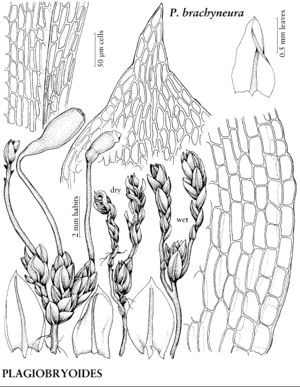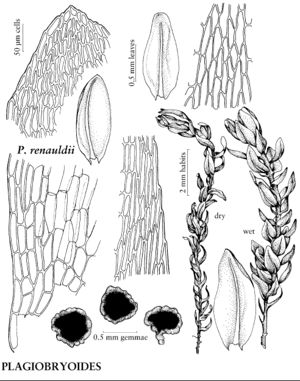Plagiobryoides
Phytologia 87: 24. 2005.
| Taxon | Illustrator ⠉ | |
|---|---|---|
 | Plagiobryoides brachyneura | Patricia M. Eckel |
 | Plagiobryoides renauldii | Patricia M. Eckel |
 | Plagiobryoides vinosula | Patricia M. Eckel |
Plants small to large, in dense turfs, green, yellow-green, redbrown, pink, or red. Stems 0.5–4 cm, evenly foliate, not or rarely weakly julaceous, somewhat branched; rhizoids few (many in P. brachyneura), micronemata and macronemata absent from stems or present in clusters on proximal stem. Leaves imbricate to somewhat contorted when dry, erect to erect-spreading when moist, ovate to suborbicular, flat to concave, 0.4–3 (–3.5) mm; base decurrent or not; margins plane or sometimes recurved proximally, ± entire, 1–3-stratose, limbidium absent or present; apex obtuse to acute; costa not reaching apex to very short-excurrent, apiculus smooth, guide cells absent or sometimes present proximally; alar cells not differentiated from juxtacostal cells; laminal areolation somewhat heterogeneous; proximal laminal cells usually long-rectangular, 3–5: 1; medial and distal cells highly variable, irregularly rhomboidal, sometimes ± quadrate near apex, usually wider than 16 µm, 1–4: 1, walls thin or incrassate, not pitted. Specialized asexual reproduction absent or by rhizoidal tubers red, spheric, greater than 200 µm. Sexual condition dioicous or rarely synoicous; perigonia and perichaetia terminal, leaves same size as vegetative leaves or usually larger, not forming rosette, inner leaves little differentiated. Seta single, straight to flexuose or twisted, rarely geniculate. Capsule inclined to suberect, elongate-pyriform, not zygomorphic, 2–4 mm; hypophysis differentiated, often elongate; operculum conic, apiculate or not, not rostrate; peristome double; exostome pale-yellow or tan proximally, hyaline distally, teeth lanceolate; endostome separate from exostome or sometimes adherent, basal membrane high, segments rarely longer than exostome, rarely absent, narrowly perforate, cilia absent or sometimes present. Spores shed singly, 11–28 µm, papillose or smooth, pale-brown, tan, or yellow-tan.
Distribution
North America, Mexico, West Indies, Central America, South America, se Asia, Africa, w Pacific Islands, Australia, tropical to warm-temperate regions
Discussion
Species 15 (5 in the flora).
Plagiobryoides is similar to Plagiobryum in gametophyte structure, but has more or less symmetric capsules with the endostome typically shorter than the exostome, and spores that are shed singly. The two genera are probably closely related, with primary speciation of Plagiobryum in arctic-alpine regions of the Northern Hemisphere and Plagiobryoides in the Tropics. Although the genus was originally described for the highly unusual Plagiobryoides incrassatolimbata, the overall leaf structure, especially the laminal areolation, is similar to that of the other species, with typically very broad thin-walled cells, becoming very long proximally, while the capsules are also similar in overall shape. As in Plagiobryum, the endostome segments can sometimes be longer than the exostome teeth, especially in some populations of Plagiobryoides cellularis. Several species have only recently been collected in the flora area, and are quite rare. B. H. Allen (2002) provided valuable information on the Neotropical species. The leaves are usually red at the base. The leaf apices are not hyaline; the innovation leaves are smaller than the cauline leaves, with more obtuse apices and weaker costae; the setae are red-brown; the capsules are brown; and the exostome teeth are trabeculate and without pores.
Selected References
None.
Lower Taxa
Key
| 1 | Stems often to 4 cm; leaves somewhat crowded; plants often red to red-brown; leaf bases long-decurrent; limbidium present, (1-)2-4-stratose; specialized asexual reproduction absent. | Plagiobryoides incrassatolimbata |
| 1 | Stems usually 0.5-2 cm; leaves crowded or distant; plants pale pink-green, green, yellow-green, or olive green; leaf bases not or somewhat decurrent; limbidium absent or 1-stratose; specialized asexual reproduction sometimes present | > 2 |
| 2 | Specialized asexual reproduction absent; sexual condition synoicous; peristome reduced; exostome teeth irregular, often short; endostome adherent to exostome, cilia absent; spores 18-22 µm. | Plagiobryoides brachyneura |
| 2 | Specialized asexual reproduction sometimes present; sexual condition dioicous; peristome when present well developed; exostome teeth lanceolate, long; endostome not adherent to exostome, cilia usually absent, occasionally 1 or 2; spores 18-28 µm | > 3 |
| 3 | Leaf apices broadly acute to obtuse; costae not reaching apex to rarely percurrent; leaves concave; bases somewhat decurrent. | Plagiobryoides renauldii |
| 3 | Leaf apices acute; costae reaching apex to very short-excurrent; leaves flat or weakly concave; bases not decurrent | > 4 |
| 4 | Distal laminal cells 2-4:1; plants pale pink-green; leaves imbricate when dry; specialized asexual reproduction absent; capsules with hypophysis strongly differentiated, elongate. | Plagiobryoides cellularis |
| 4 | Distal laminal cells 1-3:1; plants bright green; leaves somewhat contorted to imbricate when dry; specialized asexual reproduction by rhizoidal tubers; capsules with hypophysis weakly differentiated, short. | Plagiobryoides vinosula |
"narrower" is not a number."narrow" is not a number.